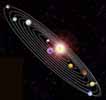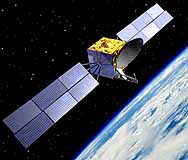| . |  |
. |
Seattle - October 21, 1999 -  Seattle - October 21, 1999 - Many giant planets come to a fiery end when their parent stars swallow them whole, new observations suggest.
Seattle - October 21, 1999 - Many giant planets come to a fiery end when their parent stars swallow them whole, new observations suggest.Guillermo Gonzalez, an astronomer at the University of Washington in Seattle, was intrigued to discover three years ago that 51 Pegasi, the first star other than the Sun that astronomers found to have a planet, had lots of heavy elements in its atmosphere. He thought this might be because the star had swallowed one or more giant planets. This made sense, according to calculations by Doug Lin of the University of California at Santa Cruz. He had earlier predicted that forces in the dusty discs where planets form would push them into their parent stars. Gonzalez and his colleague Chris Laws say that they have now analysed light from eight stars with nearby giant planets or "hot Jupiters". In a paper due to be published in The Astronomical Journal, they report that all the stars have higher than average levels of iron, carbon and other heavy elements. "That's what you'd expect if you throw planets into a star," Gonzalez says. He admits that his idea is controversial. Planets may simply form more easily in environments where there are lots of heavy materials: "The whole debate is now a chicken and egg question." Alan Boss, an astrophysicist at the Carnegie Institution of Washington, finds the question intriguing. "It's stunning for these stars with hot Jupiters to have more heavy elements than average," he says. He thinks environments rich in heavy materials help build planets, and suspects that planetary material falling onto a star would become too diluted to be detected. However, Lin thinks it is easier to explain Gonzalez's findings if planets have plunged into the stars. His computer simulations of a giant planet crashing into a Sun-like star show that 90 per cent of the planet's remains stay in the star's outer envelope. "If you contaminate the outer layers of these stars with 10 to 100 Earth masses of heavy material, that would be enough to be seen." All the astronomers agree that more observations should resolve the controversy. Gonzalez hopes to study pairs of stars that formed in the same environment, one with planets and one without. "That would convince me," he says. This article will appear in the October 23 issue of New Scientist New Scientist. Copyright 1999 - All rights reserved. The material on this page is provided by New Scientist and may not be published, broadcast, rewritten or redistributed without written authorization from New Scientist.
 Sunnyvale - October 21, 1999 -
Sunnyvale - October 21, 1999 - Japan's NTT DoCoMo has selected a Lockheed Martin and Orbital Sciences team to build and launch DoCoMo's N-STARc geostationary communications satellite. |
|
|
|
|
|
|
|
|
|
|
|
|
|
| The content herein, unless otherwise known to be public domain, are Copyright 1995-2006 - SpaceDaily.AFP and UPI Wire Stories are copyright Agence France-Presse and United Press International. ESA PortalReports are copyright European Space Agency. All NASA sourced material is public domain. Additionalcopyrights may apply in whole or part to other bona fide parties. Advertising does not imply endorsement,agreement or approval of any opinions, statements or information provided by SpaceDaily on any Web page published or hosted by SpaceDaily. Privacy Statement |